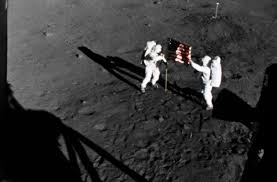Apollo 11 represents one of the greatest achievements in human history, a mission that brought the first humans to the surface of the Moon and safely back to Earth. Launched by NASA on July 16, 1969, and landing on the Moon on July 20, 1969, the Apollo 11 mission captured the imagination of millions around the world and remains a symbol of human ingenuity, courage, and determination. In this article, we’ll explore the full story of Apollo 11, from its ambitious beginnings to its lasting legacy.
The Race to the Moon
Apollo 11 was the result of an intense space race between the United States and the Soviet Union during the Cold War. After the Soviet Union launched Sputnik 1 in 1957, the first artificial satellite, and then put the first human, Yuri Gagarin, into space in 1961, the U.S. was determined to prove its technological superiority.
In 1961, President John F. Kennedy delivered a speech before Congress declaring, “I believe that this nation should commit itself to achieving the goal, before this decade is out, of landing a man on
Mission Objectives
Apollo 11 had several primary goals:
- Perform a manned lunar landing and return.
- Collect lunar samples for scientific analysis.
- Deploy scientific equipment on the lunar surface.
- Take photographs and conduct surface operations.
To achieve this, NASA developed the Saturn V rocket, the most powerful rocket ever built, and trained a team of astronauts, engineers, and scientists to support the mission.
The Crew of Apollo 11
Apollo 11 was crewed by three astronauts:
- Neil A. Armstrong – Mission Commander
- Edwin “Buzz” E. Aldrin Jr. – Lunar Module Pilot
- Michael Collins – Command Module Pilot
Neil Armstrong and Buzz Aldrin would land on the Moon, while Michael Collins would remain in orbit aboard the Command Module, “Columbia.”
The Launch and Journey
On July 16, 1969, at 9:32 a.m. Over 1 million people gathered near Cape Canaveral to witness the launch, and millions more watched it live on television.
After reaching Earth orbit, the spacecraft performed a trans-lunar injection, beginning its 384,000-kilometer journey to the Moon.
Lunar Landing: The Eagle Has Landed
The landing was not without challenges. As they approached the designated landing site in the Sea of Tranquility, Armstrong noticed large boulders and had to manually pilot the module to a safer spot. With only 30 seconds of fuel remaining, the Eagle touched down.
Armstrong then radioed back the famous words:
“Houston, Tranquility Base here. The Eagle has landed.”
The First Steps on the Moon
At 10:56 p.m. EDT, on July 20, Neil Armstrong descended the ladder of the Lunar Module and became the first human to walk on the Moon.
Buzz Aldrin joined him shortly after, calling the surface “magnificent desolation.”
They collected 47.5 pounds (21.5 kg) of lunar rock and soil samples, took photographs, and set up scientific experiments, including a seismometer and a laser reflector.
Return to Earth
After about 21 hours on the Moon, Armstrong and Aldrin returned to the Lunar Module and prepared for lift-off. The crew then began their journey back to Earth, re-entering Earth’s atmosphere on July 24, 1969, and landing in the Pacific Ocean near Hawaii. They were recovered by the USS Hornet aircraft carrier and placed in quarantine to ensure no contamination.
Technological Breakthroughs
It demonstrated major technological advancements:
- Computer Systems: The Apollo Guidance Computer (AGC) was one of the earliest digital computers used in space.
- Navigation and Communication: Innovations in telemetry, tracking, and communication laid the groundwork for future space missions.
The mission’s success proved that humans could live and work in space, setting the stage for space stations, Mars exploration, and commercial spaceflight.
Global Impact and Legacy
Apollo 11 was watched by over 600 million people, a record audience at the time. It united humanity in a shared moment of triumph and showcased what was possible through cooperation, science, and perseverance.
It also influenced culture, appearing in art, film, music, and literature.
In later years, Armstrong, Aldrin, and Collins became global ambassadors for space exploration. Neil Armstrong passed away in 2012, Michael Collins in 2021, and Buzz Aldrin, as of 2025, remains the last surviving member of the Apollo 11 crew.
Conclusion: A Giant Leap That Endures
More than 50 years later, Apollo 11 remains a powerful symbol of human achievement. It was not just a mission to the Moon; it was a demonstration of what people can accomplish when they dare to dream big and work together.
NASA continues to honor the Apollo legacy with the Artemis program, aiming to return humans to the Moon and eventually to Mars. As we look forward to the next era of space exploration, Apollo 11 stands as a reminder of our boundless curiosity and our capacity for greatness.



